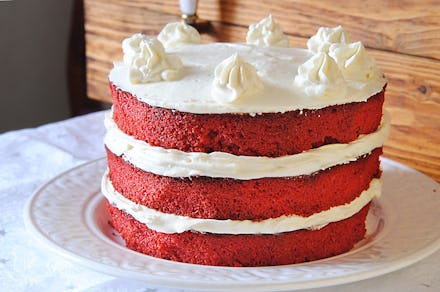What makes red velvet cake red? The truth is part science, part deceit.

Since the cupcake craze began in the early aughts, sweets lovers have been obsessed with red velvet anything and everything. Red velvet cookies, ice cream, ice cream sandwiches, lattes, red velvet cupcake flavored lite yogurt ... name something after the scarlet-hued baked good, and suddenly it's tempting trendy and delicious. Does it even matter that red velvet is just dyed chocolate?
The original red velvet, and the most authentic red velvet cakes, don't use drops of red food dye, but turn red when the cocoa powder in the batter reacts with vinegar and baking soda, explained Magnolia Bakery Chief Baking Officer Bobbie Lloyd. "This [reaction] creates a brownish-red color and it's typically dyed red to create that bright red color you see with red velvet cake," she said in an interview. Vinegar is used in pies and cakes beyond red velvet, a technique developed during the Great Depression to help add fluffiness and richness to baked desserts in lieu of more expensive ingredients.
Authentic red velvet cake uses this baking soda and vinegar chemistry (think elementary school volcano) to get the red hue, though imitation red velvet may just use artificial dye (or natural dye, for that matter) to add the red color.
Though the invention of red velvet cake is hard to pin down, it's generally considered that the cake originated in the late 19th century, when velvet cakes were popular in Victorian kitchens, or the early 20th century. Red velvet cake also is prevalent in soul food and southern cooking, and has been tied to Juneteenth celebrations in Harlem, when red food is traditionally served as a symbol of bloodshed during slavery and the Civil War. Perhaps the first official record of red velvet cake is on the 1940s era menu at the Waldorf-Astoria Hotel, a venue that claims responsibility for creating a feast of iconic dishes, including eggs Benedict and the aptly named Waldorf salad.
And while eggs Benedict flavored milkshakes haven't quite made it big, the classic red velvet recipe has been excessively commercialized and co-opted in food products in the last decades. Why? The visuals, or perhaps Instagram, may be to blame.
"Red velvet cake is very pretty... it's a lovely pop of color when you cut into it," Lloyd said of red velvet's undying popularity. "When it first became popular, it was very unique, not something you would see everywhere, and I think people delighted in the fact that it was so colorful ... Nowadays, [red velvet] makes for a great social media shot."
Eager to make your own red velvet? Lloyd, who has whipped up countless batches of red velvet batter has some crimson wisdom.
"Since red velvet cake is made using the creaming method, it's important to make sure the butter is the correct temperature and that you cream the butter and sugar long enough," Lloyd said. "Be sure to follow the directions so that both elements are correct."